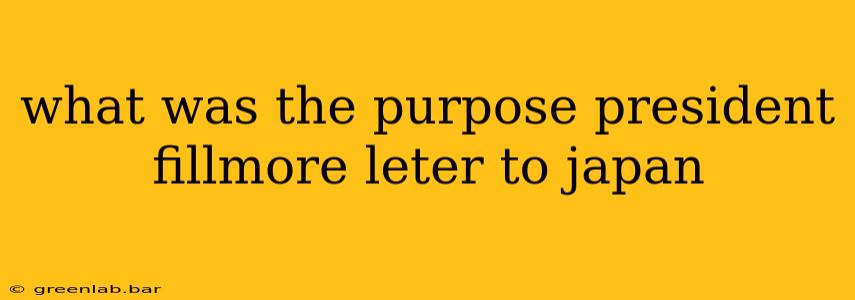President Millard Fillmore's letter to the Emperor of Japan, delivered in 1853 by Commodore Matthew Perry, was a pivotal moment in the history of U.S.-Japan relations. Its purpose wasn't simply a friendly greeting; it was a carefully crafted diplomatic overture aimed at achieving specific, crucial goals:
The Primary Purpose: Establishing Trade Relations
The most significant objective of Fillmore's letter was to open Japan to American trade. For decades, Japan had pursued a policy of sakoku (national isolation), severely restricting contact with the outside world. This limited access hampered American whaling ships and merchant vessels in the Pacific, and the US sought to establish a reliable port for supplies and repairs. The letter explicitly requested the establishment of a trading relationship, emphasizing the mutual benefits such an arrangement would bring. Fillmore highlighted the superior American goods and the potential for economic prosperity for both nations through commerce.
Secondary Purposes: Diplomacy and Protection of American Mariners
Beyond trade, the letter served several other critical purposes:
1. Formal Diplomatic Recognition:
Fillmore's letter aimed to establish formal diplomatic relations with Japan. The letter wasn't merely a request; it was a statement of the United States' intention to engage in peaceful and mutually respectful diplomatic interactions. It sought to initiate a dialogue that would transcend mere commercial interests and pave the way for long-term cooperation.
2. Protecting American Mariners:
The letter also addressed the issue of protecting American sailors and ships who were sometimes stranded or in distress along the Japanese coast. The US sought assurances of humane treatment and assistance for its citizens should they encounter difficulties in Japanese waters. This concern underscored the practical and humanitarian aspects of the diplomatic initiative.
3. Demonstrating American Naval Power (Implicit Purpose):
While not explicitly stated in the letter itself, the delivery method played a significant role. Commodore Perry's arrival with a powerful naval squadron served as a clear demonstration of American military might. This implicit message signaled the United States' determination to secure its objectives, adding weight to the diplomatic overture. The show of force underscored the seriousness of the American intentions.
The Letter's Impact: A Turning Point in Japanese History
Fillmore's letter, coupled with Perry's expedition, ultimately proved successful in its primary and secondary purposes. Although initially met with resistance, the letter's persuasive arguments, combined with the impressive display of naval power, ultimately led to the signing of the Treaty of Kanagawa in 1854. This treaty opened two Japanese ports to American ships, granted consular protection to American citizens, and marked the beginning of the end of Japan's self-imposed isolation. This event had a profound and lasting impact on Japan, initiating a period of modernization, international engagement, and significant societal change.
In conclusion, President Fillmore's letter to Japan was a carefully considered diplomatic instrument designed to achieve several key objectives, primarily the establishment of trade relations and the formalization of diplomatic ties. Its success marked a pivotal moment in history, altering the course of both American and Japanese history.

